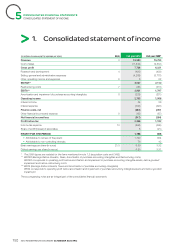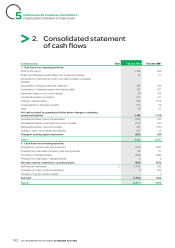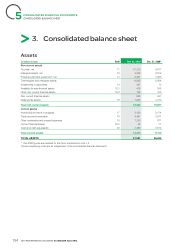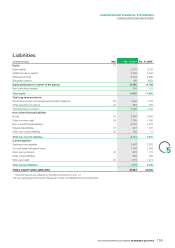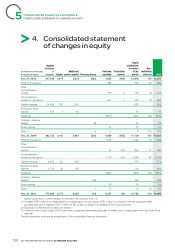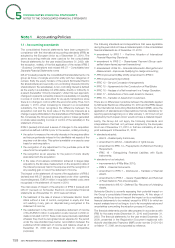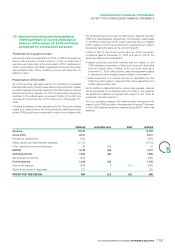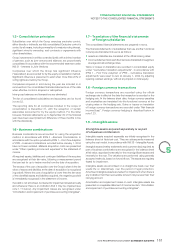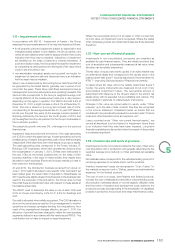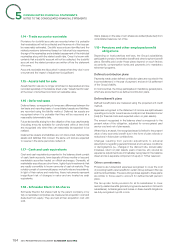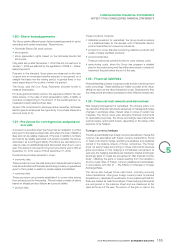APC 2010 Annual Report Download - page 160
Download and view the complete annual report
Please find page 160 of the 2010 APC annual report below. You can navigate through the pages in the report by either clicking on the pages listed below, or by using the keyword search tool below to find specific information within the annual report.
CONSOLIDATED FINANCIAL STATEMENTS
5NOTES TO THE CONSOLIDATED FINANCIAL STATEMENTS
Note1
Accounting Policies
1.1 - Accounting standards
The consolidated financial statements have been prepared in
compliance with the international accounting standards (IFRS) as
adopted by the European Union as of December31, 2010. The
same accounting methods were used as for the consolidated
fi nancial statements for the year ended December31, 2009, with
the exception, notably, of the fi rst application of the revised IFRS3
- Business Combinations and revised IAS27 – Consolidated and
Seperate Financial Statements norms
IAS27 (revised) presents the consolidated fi nancial statements of a
group as those of a single economic entity with two categories of
owners: fi rstly the equity holders of the parent (Schneider Electric
SA shareholders) and secondly non-controlling interests (minority
shareholders in the subsidiaries). A non-controlling interest is defi ned
as the equity in a subsidiary not attributable, directly or indirectly, to
a parent (hereinafter “minority interests”). Under this new approach,
changes in a parent’s ownership interest in a subsidiary not resulting
in a loss of control are accounted for as equity transactions since
there is no change in control within the economic entity. Thus, from
January1, 2010, when increasing its interest in a consolidated
subsidiary, the Group recognises the difference between the
acquisition cost and the book value of the minority interests as a
change in equity attributable to the shareholders of Schneider Electric
SA. Conversely, the Group recognises any gains or losses generated
on share sales resulting in a loss of control of the subsidiary in the
statement of income.
IFRS3 (revised) introduced a series of changes to the acquisition
method as defi ned in IFRS3 prior to the revision, notably including:
•the option to measure the minority interests in the acquiree either
as their proportionate interest in the identifi able net assets of the
acquiree or at fair value. This option is available on a case by case
basis for each acquisition;
•the recognition of any adjustment to the purchase price at fair
value from the acquisition date;
•the recognition as an expense for the period of costs directly
associated with the acquisition;
•in the case of a business combination achieved in stages (step
acquisition), the fair value measurement on the acquisition date of
the interest previously held in the acquiree and the recognition of
any resulting gain or loss in the statement of income.
The impact on the statement of income of the application of IFRS3
(revised) and IAS27 (revised) is recognised under other operating
income/(expense). EUR31million in acquisition-related costs were
recognised in the statement of income in 2010.
The main areas of impact of the adoption of IFRS3 (revised) and
IAS27 (revised) on Schneider Electric’s consolidated financial
statements as of December31, 2010 were as follows:
•the treatment of the sale of shares in Schneider Electric South
Africa without a loss of control, recognised in equity and thus
not resulting in any gain on disposal being recognised in the
statement of income;
•the restatement in the 2009 comparative statement of income
of the EUR25.8million in acquisition costs incurred in 2009 on
deals concluded in 2010; these costs were previously capitalised
whereas they must be recognised as an expense for the period
under the new standard (see below: reconciliation between the
published 2009 statement of income and balance sheet as of
December 31, 2009 and those presented for comparative
purposes).
The following standards and interpretations that were applicable
during the period did not have a material impact on the consolidated
fi nancial statements as of December31, 2010:
•amendment to IFRS 1 – First-time Adoption of International
Financial Reporting Standards;
•amendment to IFRS 2 – Share-based Payment (Group cash-
settled share-based payment transactions);
•amendement of IAS39 – Financial instruments: Recognition and
Measurement – Exposures Qualifying for Hedge Accounting;
•IFRS improvements (May2008): amendment to IFRS5;
•IFRS improvements (April2009);
•IFRIC12 – Service Concession Arrangements;
•IFRIC15 – Agreements for the Construction of Real Estate;
•IFRIC16 – Hedges of a Net Investment in a Foreign Operation;
•IFRIC17 – Distributions of Non-cash Assets to Owners;
•IFRIC18 – Transfers of Assets from Customers.
There are no differences in practice between the standards applied
by Schneider Electric as of December31, 2010 and the IFRSs issued
by the International Accounting Standards Board (IASB), since the
application of standards and interpretations that are mandatory for
reporting periods beginning on or after January1, 2010 but not yet
adopted by the European Union would not have a material impact.
Lastly, the Group did not apply the following standards and
interpretations that had not yet been adopted by the European
Union as of December31, 2010 or that are mandatory at some
point subsequent to December31, 2010:
•standards adopted:
–IAS24 – Related party disclosures,
–amendment to IAS32 – Classifi cation of rights issues,
–amendment to IFRIC14 – Prepayments of a Minimum Funding
Requirement,
–IFRIC 19 - Extinguishing Financial Liabilities with Equity
Instruments;
•standards not yet adopted:
–improvements to IFRSs (May2010),
–IFRS9 - Financial Instruments,
–amendment to IFRS7 – Disclosures – Transfers of fi nancial
assets,
–amendments to IFRS1 – Severe Hyperinfl ation and Removal
of Fixed Dates for First-time Adopters,
–amendments to IAS12 – Deferred Tax: Recovery of Underlying
Assets.
Schneider Electric is currently assessing their potential impact on
the Group’s consolidated financial statements. At this stage of
analysis, the Group does not expect the impact on its consolidated
fi nancial statements to be material, except for IFRS9 for which an
impact analysis has not yet begun, due to its incomplete nature and
uncertainties surrounding the adoption process in Europe.
The fi nancial statements provide data prepared in accordance with
IFRS for the years ended December31, 2010 and December31,
2009. The fi nancial statements for the year ended December31,
2008, presented in the Registration Document registered with
Autorité des Marchés Financiers (AMF) under number D 09-0124
on March17, 2009, are incorporated by reference.
2010 REGISTRATION DOCUMENT SCHNEIDER ELECTRIC158




